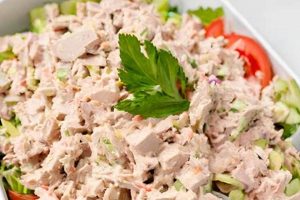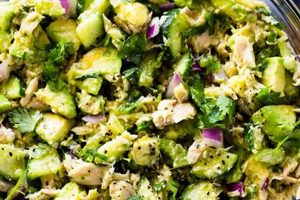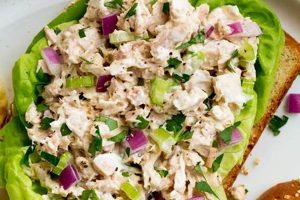A mayonnaise-free tuna salad sandwich offers a lighter, often healthier alternative to the traditional recipe. It typically involves substituting the mayonnaise with ingredients like plain yogurt, Greek yogurt, avocado, or a combination of these, blended with tuna and other common additions such as celery, onion, and seasonings. This approach caters to individuals with dietary restrictions, those seeking lower-fat options, or simply those who prefer a different flavor profile.
Eliminating mayonnaise reduces the overall fat and calorie content, making the sandwich more appealing for health-conscious consumers. Furthermore, alternative ingredients can introduce different textures and tastes, potentially broadening the appeal of tuna salad. The rise in popularity of this variation reflects a growing demand for customizable and healthier meal options. This shift aligns with broader dietary trends emphasizing fresh, whole-food ingredients.
The following sections will delve into specific mayonnaise-free tuna salad sandwich recipes, exploring variations with different base ingredients, flavor profiles, and nutritional information. Tips for preparation, storage, and serving suggestions will also be provided.
Tips for Crafting Delicious Mayonnaise-Free Tuna Salad
Creating a flavorful and satisfying tuna salad without mayonnaise requires careful consideration of ingredient selection and preparation techniques. These tips offer guidance for achieving optimal results.
Tip 1: Drain the Tuna Thoroughly: Excess liquid can dilute the flavor and create a watery consistency. Pressing the tuna gently with a fork or paper towel removes unwanted moisture.
Tip 2: Choose a Suitable Replacement: Consider the desired texture and flavor when selecting a mayonnaise alternative. Greek yogurt offers a tangy, creamy texture, while mashed avocado provides richness and a mild flavor.
Tip 3: Enhance the Flavor Profile: Incorporating fresh herbs like dill or chives, spices like paprika or celery seed, and a squeeze of lemon juice elevates the taste complexity.
Tip 4: Add Texture with Crunchy Vegetables: Finely diced celery, red onion, or water chestnuts provide a satisfying crunch and contrast to the softness of the tuna and base ingredient.
Tip 5: Season Gradually and Taste Frequently: Start with a small amount of salt and pepper, then adjust according to preference. Tasting throughout the mixing process ensures a balanced flavor.
Tip 6: Chill Before Serving: Allowing the tuna salad to chill in the refrigerator for at least 30 minutes allows the flavors to meld and the mixture to firm up.
Tip 7: Explore Bread and Serving Options: Consider whole-wheat bread, lettuce wraps, or crackers for a variety of presentations. Serving the salad with fresh greens or sliced tomatoes adds nutritional value.
By following these guidelines, one can achieve a delicious and wholesome tuna salad that satisfies both nutritional and culinary goals.
These tips lay the foundation for creating numerous variations on the mayonnaise-free tuna salad sandwich. The following section will provide a selection of specific recipes to explore.
1. Healthy Alternatives
Healthy alternatives play a crucial role in the “tuna salad sandwich recipe no mayo” concept. The primary objective is to replace mayonnaise, a high-fat ingredient, with options that offer comparable texture and flavor while improving the nutritional profile. This shift addresses health concerns associated with high-fat diets, such as increased risk of heart disease and obesity. Substituting mayonnaise with ingredients like Greek yogurt, avocado, or hummus allows for a significant reduction in saturated fat and cholesterol while introducing beneficial nutrients like protein, healthy fats, and fiber. For example, Greek yogurt provides a creamy texture similar to mayonnaise but with a higher protein content and probiotics that support gut health. Avocado offers healthy monounsaturated fats and a rich, creamy texture. Hummus introduces plant-based protein and fiber, contributing to a more balanced nutritional profile.
The practical significance of incorporating healthy alternatives extends beyond individual health benefits. It contributes to a broader shift towards more mindful eating habits and encourages exploration of diverse culinary options. By demonstrating that flavor and health can coexist, this approach promotes sustainable dietary changes. Using avocado, for example, not only adds healthy fats but also introduces a subtle, complementary flavor to the tuna. Greek yogurt’s tanginess can be balanced with herbs and spices, creating a complex and satisfying flavor profile. This adaptability demonstrates that healthy alternatives can seamlessly integrate into existing recipes without compromising taste.
In summary, the emphasis on healthy alternatives within the “tuna salad sandwich recipe no mayo” framework signifies a conscious effort to prioritize nutrition without sacrificing flavor or satisfaction. The ability to adapt recipes with readily available, wholesome ingredients empowers individuals to make informed dietary choices that support long-term well-being. This approach challenges the notion that healthy eating requires restrictive or unappetizing meals, demonstrating that flavor and nutrition can be harmoniously combined.
2. Flavor Enhancement
Flavor enhancement takes center stage when mayonnaise is omitted from tuna salad. Mayonnaise, while contributing richness and creaminess, also provides a significant portion of the flavor profile. Its absence necessitates careful consideration of alternative flavoring agents to create a balanced and palatable outcome. This section explores key facets of flavor enhancement in mayonnaise-free tuna salad.
- Herbs and Spices
Fresh herbs like dill, parsley, chives, and cilantro introduce bright, herbaceous notes. Dried spices such as paprika, celery seed, garlic powder, and onion powder contribute depth and complexity. The selection should complement the other ingredients and create a cohesive flavor profile. For instance, dill pairs well with lemon juice and Greek yogurt, while paprika adds a smoky warmth that complements avocado. Experimentation is key to achieving desired flavor combinations.
- Acidity
A touch of acidity brightens the flavors and balances the richness of the tuna. Lemon juice, lime juice, or vinegar are common choices. The level of acidity should be adjusted to personal preference and the overall flavor profile. Lemon juice, for example, provides a classic pairing with seafood, while lime juice offers a slightly sweeter and more tropical note. Apple cider vinegar contributes a mild tang.
- Aromatics
Finely chopped red onion, shallots, or garlic contribute pungent, aromatic notes that enhance the overall flavor experience. These ingredients should be used sparingly to avoid overpowering the delicate flavor of the tuna. Red onion provides a sharp bite, while shallots offer a milder sweetness. A small amount of finely minced garlic adds a savory depth.
- Umami Boosters
Ingredients rich in umami, such as Worcestershire sauce, soy sauce, or nutritional yeast, can elevate the savory depth of the tuna salad. These ingredients should be used judiciously to avoid excessive saltiness. Worcestershire sauce adds a complex savory flavor, while soy sauce contributes a salty, umami richness. Nutritional yeast provides a cheesy, nutty flavor.
By thoughtfully combining these flavor-enhancing elements, a mayonnaise-free tuna salad can achieve a depth and complexity that rivals its traditional counterpart. The absence of mayonnaise provides an opportunity to explore a wider range of flavor profiles, resulting in a more nuanced and satisfying culinary experience.
3. Texture
Texture plays a vital role in the overall enjoyment of a tuna salad sandwich, particularly when mayonnaise is absent. Mayonnaise contributes a significant creamy texture, and its removal necessitates thoughtful consideration of alternative ingredients and preparation techniques to achieve a satisfying mouthfeel. This section explores key facets of texture in a mayonnaise-free tuna salad.
- Base Ingredient
The choice of mayonnaise alternative significantly impacts the final texture. Greek yogurt provides a creamy, slightly tangy base, while mashed avocado offers a richer, smoother texture. Hummus contributes a thicker, more paste-like consistency. The selection should align with individual preferences and the desired outcome. For instance, those seeking a lighter texture might prefer Greek yogurt, while those desiring a richer mouthfeel could opt for avocado.
- Vegetable Additions
Incorporating chopped vegetables introduces textural contrast. Finely diced celery, red onion, bell peppers, or water chestnuts provide a satisfying crunch. The size of the chop influences the perceived texture; smaller pieces blend seamlessly, while larger pieces offer more pronounced crunch. Consider the overall balance; too much crunch can detract from the other elements, while too little can result in a monotonous texture.
- Tuna Preparation
The way the tuna is prepared influences the texture. Flaking the tuna into large chunks creates a more substantial, textured experience, while finely shredding it results in a smoother, more homogenous mixture. The choice depends on personal preference and the desired outcome. Large chunks provide a more noticeable tuna presence, while finely shredded tuna integrates more seamlessly with the other ingredients.
- Binding Agents
In some cases, a small amount of binding agent may be necessary to achieve the desired consistency, particularly when using watery vegetables like cucumbers or tomatoes. A tablespoon or two of mashed avocado, Greek yogurt, or even a small amount of mashed chickpeas can help bind the ingredients together without significantly altering the flavor profile. Overuse of binding agents, however, can result in a heavy, dense texture.
By carefully considering these textural elements, a mayonnaise-free tuna salad can achieve a satisfying and enjoyable mouthfeel. Balancing the creaminess of the base ingredient with the crunch of vegetables and the texture of the tuna itself creates a multi-dimensional sensory experience that enhances the overall enjoyment of the sandwich.
4. Fresh Ingredients
Fresh ingredients are paramount in crafting a superior mayonnaise-free tuna salad sandwich. The absence of mayonnaise, which often masks the flavors of less-than-fresh ingredients, necessitates a focus on high-quality components. This emphasis on freshness elevates the overall flavor profile and nutritional value of the sandwich.
- High-Quality Tuna
Opting for high-quality canned tuna packed in water or olive oil, rather than oil, significantly impacts the flavor and nutritional content. Tuna packed in water offers a cleaner taste, allowing the other ingredients to shine. Higher-grade tuna varieties, such as albacore, possess a firmer texture and more delicate flavor compared to chunk light tuna. This selection influences the overall taste and perceived quality of the final product.
- Fresh Produce
Utilizing crisp, fresh vegetables enhances both the flavor and texture. Recently harvested celery, onions, and bell peppers contribute a vibrant crunch and distinct flavors that complement the tuna. Wilted or aged produce can impart undesirable flavors and textures, detracting from the overall experience. Incorporating seasonal vegetables further enhances the flavor profile and nutritional value.
- Herbs and Aromatics
Fresh herbs, such as dill, parsley, chives, or cilantro, contribute bright, vibrant flavors that elevate the tuna salad. Dried herbs can be used as a substitute, but fresh herbs offer a superior flavor profile and aroma. Similarly, freshly minced garlic or shallots provide a more pungent and nuanced flavor compared to their powdered counterparts. These aromatic additions contribute significantly to the complexity and freshness of the salad.
- Proper Storage
Proper storage of ingredients preserves their freshness and prevents spoilage. Refrigerating prepped vegetables in airtight containers maintains their crispness and prevents oxidation. Similarly, keeping the prepared tuna salad chilled until ready to serve prevents bacterial growth and preserves its flavor. These practices contribute to a safer and more enjoyable culinary experience.
Prioritizing fresh, high-quality ingredients elevates the mayonnaise-free tuna salad sandwich from a simple lunch to a flavorful and nutritious meal. The absence of mayonnaise allows the natural flavors of these ingredients to shine, resulting in a more complex and satisfying sensory experience. This emphasis on freshness aligns with broader culinary trends that prioritize whole foods and natural flavors, underscoring the importance of ingredient quality in achieving optimal taste and nutrition.
5. Recipe Variations
Recipe variations represent a crucial aspect of the “tuna salad sandwich recipe no mayo” concept. Eliminating mayonnaise opens avenues for diverse flavor profiles and ingredient combinations, catering to individual preferences and dietary needs. This flexibility allows for the creation of unique and satisfying culinary experiences that extend beyond the limitations of traditional tuna salad. The adaptability inherent in mayonnaise-free recipes fosters culinary creativity and encourages exploration of a wider range of ingredients.
Several factors contribute to the importance of recipe variations. Health considerations often drive the choice to omit mayonnaise, prompting exploration of lower-fat alternatives and the incorporation of nutrient-rich ingredients. Flavor preferences also play a significant role; some individuals may prefer the tang of Greek yogurt, while others might appreciate the richness of avocado. Dietary restrictions, such as veganism or gluten intolerance, necessitate further adaptations. For example, a vegan variation might incorporate a chickpea-based mayonnaise alternative, while a gluten-free version would require the use of gluten-free bread or lettuce wraps. These variations demonstrate the adaptability of the core concept and its ability to accommodate diverse dietary needs.
Practical applications of recipe variations abound. A Mediterranean-inspired version might include Kalamata olives, feta cheese, and a lemon-herb dressing. An Asian-inspired variation could incorporate shredded carrots, ginger, soy sauce, and sesame oil. A Southwestern-inspired recipe might feature black beans, corn, cilantro, and a lime-cumin dressing. These examples illustrate the versatility of the core recipe and its potential for customization based on culinary traditions and individual preferences. Ultimately, the ability to adapt and modify recipes empowers individuals to create meals that align with their specific needs and desires, fostering a more personalized and enjoyable dining experience.
6. Nutritional Benefits
Nutritional benefits represent a cornerstone of the “tuna salad sandwich recipe no mayo” concept. Eliminating mayonnaise, a condiment high in saturated fat and calories, significantly alters the nutritional profile of the sandwich. This shift allows for the creation of a meal that aligns with health-conscious dietary choices without sacrificing flavor or satisfaction. The reduction in saturated fat contributes to improved cardiovascular health, while the lower calorie content supports weight management goals. Replacing mayonnaise with healthier alternatives, such as Greek yogurt or avocado, introduces additional nutritional advantages. Greek yogurt provides a boost of protein and probiotics, supporting gut health and satiety, while avocado offers heart-healthy monounsaturated fats and essential vitamins. These substitutions transform the sandwich into a nutrient-rich meal option.
The practical significance of these nutritional benefits extends beyond individual health. They contribute to a broader movement towards more informed dietary choices and highlight the potential for culinary creativity within health-conscious frameworks. For instance, a tuna salad sandwich made with Greek yogurt and chopped vegetables offers a substantial source of protein, fiber, and essential vitamins, making it a suitable meal for those seeking a balanced and nutritious lunch. Replacing traditional white bread with whole-wheat bread further enhances the fiber content and provides complex carbohydrates for sustained energy. These practical applications demonstrate the feasibility of incorporating nutritionally sound choices into everyday meals.
In summary, the “tuna salad sandwich recipe no mayo” concept underscores the interconnectedness of culinary enjoyment and nutritional well-being. The deliberate omission of mayonnaise and the strategic incorporation of healthier alternatives create a meal that not only satisfies the palate but also supports long-term health goals. This approach challenges the notion that healthy eating requires sacrificing flavor or convenience, demonstrating that nutritious meals can be both delicious and accessible. The focus on nutritional benefits empowers individuals to make informed food choices that contribute to overall wellness.
Frequently Asked Questions
This section addresses common inquiries regarding mayonnaise-free tuna salad preparation and its benefits.
Question 1: What are the primary advantages of omitting mayonnaise from tuna salad?
Omitting mayonnaise reduces the overall fat and calorie content, making the salad a healthier option. It also allows for greater flexibility in flavor profiles, encouraging exploration of alternative ingredients and seasonings. This approach caters to various dietary needs and preferences.
Question 2: What are the best mayonnaise substitutes in tuna salad?
Suitable substitutes include Greek yogurt, avocado, hummus, or a combination thereof. Greek yogurt provides a tangy, creamy texture, while avocado offers richness and healthy fats. Hummus introduces a distinct flavor profile and additional plant-based protein.
Question 3: How can one prevent a mayonnaise-free tuna salad from becoming dry?
Proper drainage of the tuna is crucial. Additionally, the chosen mayonnaise substitute, such as Greek yogurt or avocado, contributes moisture. A small amount of olive oil or lemon juice can also enhance moisture and flavor.
Question 4: How long can mayonnaise-free tuna salad be stored?
When stored in an airtight container in the refrigerator, mayonnaise-free tuna salad typically lasts for three to five days. Proper refrigeration is crucial for food safety.
Question 5: Beyond sandwiches, how else can mayonnaise-free tuna salad be served?
It can be served on lettuce wraps, crackers, or as a filling for bell peppers or tomatoes. It can also be used as a salad topping or incorporated into a grain bowl.
Question 6: Can canned tuna be substituted with fresh tuna in these recipes?
Fresh tuna can certainly be used. However, ensure it is properly cooked and cooled before incorporating it into the salad. Adjust seasonings accordingly, as fresh tuna may have a milder flavor than canned.
Understanding these common inquiries facilitates informed decision-making regarding preparation and consumption of mayonnaise-free tuna salad. This knowledge empowers individuals to create nutritious and flavorful meals tailored to their individual preferences and dietary requirements.
The following section offers a collection of specific mayonnaise-free tuna salad recipes, providing practical examples of these principles in action.
Conclusion
Exploration of mayonnaise-free tuna salad recipes reveals a versatile and adaptable culinary concept. Emphasis on fresh ingredients, healthy alternatives, and flavor enhancement demonstrates the potential for creating nutritious and flavorful meals. Analysis of texture, recipe variations, and nutritional benefits underscores the adaptability of this approach to accommodate diverse dietary needs and preferences. This exploration highlights the feasibility of prioritizing health-conscious choices without compromising culinary satisfaction.
The increasing demand for healthier meal options positions mayonnaise-free tuna salad as a relevant and adaptable culinary solution. Continued exploration of innovative ingredient combinations and flavor profiles promises further evolution within this culinary space. This trajectory underscores the ongoing shift towards health-conscious eating patterns and the integration of mindful food choices into everyday life.






